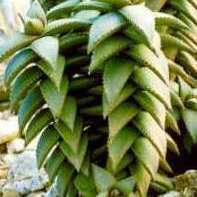Plants much branched from the base or higher, forming dense shrubby bushes 1-2 met. across. Stems many, erect, rigid, about 15 mm diam., 1-2 met. long, densely foliate for their greater length. Leaves ovate-acute to ovate-lanceolate, 7-9 cm long, 3-4 cm broad, 8-10 mm thick near base, recurved to much deflexed, basally sheathing, the sheaths very short, pale somewhat red striped; upper surface greener, convex to flat after a rainy season, becoming reddish and canaliculate in periods of drought; when green the leaves obscurely lineate, when red the lineation scarcely visible; lower surface convex, usually greener than the upper surface and more clearly green to red lineate; margins armed with pungent whitish to reddish deltoid teeth 1-2 mm long, up to 5 mm distant, usually longer and more crowded near base, becoming more distant and shorter to obsolescent upwards, the apex sometimes a single or bifid spine. Inflorescence springing laterally from near the apex of foliate stems, about 40 cm high, 2-3-branched from the middle or low down, when dichotomously 3-branched the racemes in one vertical plane. Peduncle rather slender, brown and laterally compressed near base, clothed with several broadly ovate-acuminate thin white scarious membraneous sterile bracts about 7 mm long, 5 mm broad, with 2-3 congested nerves in median line. Racemes sub-densely flowered, 9-15 cm long, about 6-7 cm diam., mostly unicoloured yellow, sometimes brick-red to red. Bracts lanceolate-acuminate, thin white scarious, 6-8 mm long, 3 mm broad, with 1 or 2 nerves in median line. Pedicels slender, the lowest about 20 mm long, slightly longer in the fruit. Perianth cylindric, slightly enlarging towards the throat, 25 mm long, yellow or brick-red, shortly stipitate and tapering from the base to the pedicel; outer segments free to the middle, the apices sub-acute slightly spreading; inner segments free, but dorsally adnate to the outer for half their length, the upper half broader than the outer, with thin white margins and a slight yellowish keel, the apices more obtuse and more spreading than the outer. Filaments pale yellow, filiform-flattened, the 3 inner narrower and lengthening in advance of the 3 outer. Anthers the 3 inner and 3 outer in turn exserted 2-4 mm Stigma at length exserted 5 mm and remaining exserted when the perianth dries. Ovary 6-7 mm long, slightly tapering into the style, finely 6-grooved. Capsule about 22 mm long, 7-8 mm long.
More
Plants erect, shrubby, 1-2 m tall. Leaves appearing 4-or 5-ranked, reflexed, 50-90 x 15-30 mm, biconvex to slightly channelled, maroon-red to greenish, with faint reddish striae, keel not dentate. Inflorescence lateral, simple to 3-branched, with scattered sterile bracts; racemes conical, subdense to capitate, very dense; bracts ±6-7 x 4 mm, 1-3-nerved. Flowers golden yellow, or red with golden expanded mouth, straight, narrow, 20-25 mm long; outer segments free to middle, inner segments free but dorsally adnate to outer for ± half their length; pedicels ±21 mm long. Anthers exserted 2-4 mm. Ovary 6-7 x 2-3 mm; style exserted 5-6 mm. Fruit ±22 x 7-8 mm.
Large, much-branched shrub, 1-2 m tall. Stem erect, carrying leaves for most of their length. Leaves dull blue-green, often reddish especially during drought, almost triangular, neatly arranged in vertical rows, curved backwards. Flowers in branched, capitate panicles, red to orange-red or yellow.


